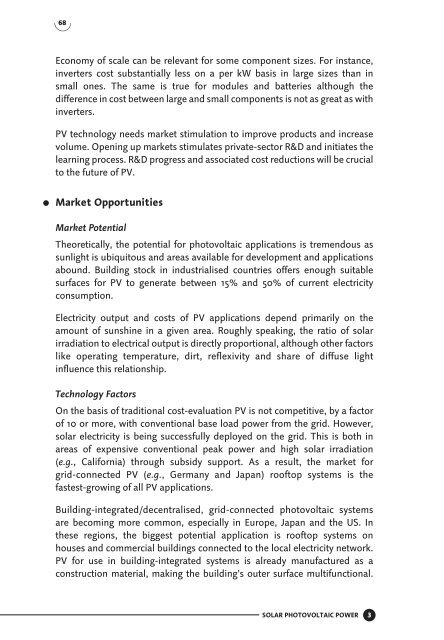Technology Status - NET Nowak Energie & Technologie AG
Technology Status - NET Nowak Energie & Technologie AG
Technology Status - NET Nowak Energie & Technologie AG
You also want an ePaper? Increase the reach of your titles
YUMPU automatically turns print PDFs into web optimized ePapers that Google loves.
68<br />
Economy of scale can be relevant for some component sizes. For instance,<br />
inverters cost substantially less on a per kW basis in large sizes than in<br />
small ones. The same is true for modules and batteries although the<br />
difference in cost between large and small components is not as great as with<br />
inverters.<br />
PV technology needs market stimulation to improve products and increase<br />
volume. Opening up markets stimulates private-sector R&D and initiates the<br />
learning process. R&D progress and associated cost reductions will be crucial<br />
to the future of PV.<br />
● Market Opportunities<br />
Market Potential<br />
Theoretically, the potential for photovoltaic applications is tremendous as<br />
sunlight is ubiquitous and areas available for development and applications<br />
abound. Building stock in industrialised countries offers enough suitable<br />
surfaces for PV to generate between 15% and 50% of current electricity<br />
consumption.<br />
Electricity output and costs of PV applications depend primarily on the<br />
amount of sunshine in a given area. Roughly speaking, the ratio of solar<br />
irradiation to electrical output is directly proportional, although other factors<br />
like operating temperature, dirt, reflexivity and share of diffuse light<br />
influence this relationship.<br />
<strong>Technology</strong> Factors<br />
On the basis of traditional cost-evaluation PV is not competitive, by a factor<br />
of 10 or more, with conventional base load power from the grid. However,<br />
solar electricity is being successfully deployed on the grid. This is both in<br />
areas of expensive conventional peak power and high solar irradiation<br />
(e.g., California) through subsidy support. As a result, the market for<br />
grid-connected PV (e.g., Germany and Japan) rooftop systems is the<br />
fastest-growing of all PV applications.<br />
Building-integrated/decentralised, grid-connected photovoltaic systems<br />
are becoming more common, especially in Europe, Japan and the US. In<br />
these regions, the biggest potential application is rooftop systems on<br />
houses and commercial buildings connected to the local electricity network.<br />
PV for use in building-integrated systems is already manufactured as a<br />
construction material, making the building’s outer surface multifunctional.<br />
SOLAR PHOTOVOLTAIC POWER X3







